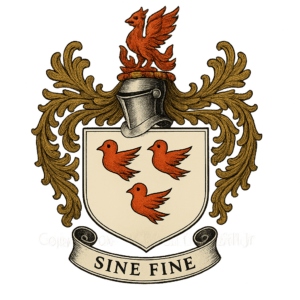
On the McGill family coat of arms is a silver field with three red martlets, the mythical bird without legs, which is in perpetual flight and represents eternal diligence. The McGill motto is Sine Fine — “Without End”.
The McGills are a sept of Clan Donald. The name (mac an Ghiolla) means ‘son of the stranger’. The McGills (clann a’ ghoill) have their own tartan, badge and slogan. McGill is a very common name in Galloway and Jura on the western coast of Scotland and is also found in Ireland.
The clan badge is the crest from the coat of arms of the vicount of Oxenford, Lord MakGill of Cousland (title now extinct) and is in the form of a phoenix rising from the flames and on the surrounding belt is the motto- ‘SINE FINE’.
Sine Fine is Latin for Without End a quite appropriate motto to accompany a phoenix. The actual arms on the crest are 3 gold martlets (birds) on a red shield. Sine Fine is used as the motto in Ireland, Wales, and England, while Scots and Ulster McGills use In Domino Confido and sometimes Grandescunt Aucta Labore, which is also used by McGill University, the English-language university located in Montreal, Quebec, Canada. The crest is the similar for all three mottos.
McGill Family Mottos
“Sine Fine” (Without End)
“In Domino Confido” (I confide in the Lord)
“Grandescunt Aucta Labore” (By work all things increase and grow)
The phoenix has some interesting associations. In Egyptian mythology the phoenix was called the Bennu bird and associated with the benben stone, thought to be depicted as a meteorite. Some tradition hold that the Stone of Destiny, which was used in ceremony by the ancient Scottish Kings of Dal Raida, is also a meteorite. The name McGill is derived from a name that is one of the earliest septs associated with Clan Donald. The most famous association of Clan Donald is that with Somerled, the last and most persecuted of all the Kings of Dalraida, who nonetheless had one of the longest reigns. There could be a relationship between the phoenix and the Stone of Destiny in Dalraidan culture.
According to the Oxenford peerage and that at Ballynester, Ireland are related with almost identical crest. The actual arms are 3 gold martlets on a red shield. The Scottish houses at Rankiellor and Ramgally have the same arms with the motto: In Domino Confido.
Original spellings are McGill, Magill, M’Gill, Mcgill, and MacGill. Irish Catholic McGills come from Scotland and were given land in Ireland in the 1300’s. They were related to the English and Welsh McGills. Protestant Irish McGills come from Scotland during the Plantation of Ulster in the 1600’s. Consider your line’s traditions when researching. Also, Catholic Scots who were driven from the Highlands in the 1750’s settled in Nova Scotia.
There are two variations, depending on the country of origin. Red shield, with 3 martlets (birds that look like canaries with no feet) The difference is this: the Irish birds are gold, and the Scottish birds are silver. Above the shield is a phoenix rising from flames. The Irish motto is “Sine Fine”, which means Without End in Latin; the Scottish motto is “In Dominus Confido” which means I trust in God, also in Latin.
There are nearly thirty obvious variations of spelling of the surname. All are pronounced virtually the same. Common spellings for ma*gill include: MacGill, Macgill, Magill, Makgill, McGill, Mcgill, MacGille, MacGyle, MacGyll, Macan’Gaill, MacGeil, MacGhill, MacGall, MacIghail, etc.
The Lord Lyon and the Standing Council of Scottish Chiefs recognize “Makgill” as the clan name, this being the name of the Chief. However, most tartan companies and the like use the “Macgill” or “Mcgill” spelling.
The Marlet
Martlet, (fr. Merlette, possibly the diminutive of the merula, merle, or blackbird): a bird resembling a swallow, with thighs but no visible legs. They form a very common bearing, being found in early Rolls, and are as common in French arms as they are in English. They may be of any tincture, even of ermine (see example under Crescent), and are very frequently represented in orle (q.v.). It is used also as the difference of the fourth son.
Yet another definition of the Martlet, also called a Swallow:
One who has been dispossessed of land. Sign for fourth son. In Ireland the Martlet was the bird of perpetual movement.
A rendition of the Martlet can be found in the McGill University Arms
The Makgill/Macgill Tartan is a beautiful tartan consisting of a sett of six colors: red, green, black, white, yellow, and blue. The registered MacGill tartan may be worn by several Scotts families: McGill, Gill, Cargill, gillen, Glen and Cairnes.
The Makgill / Macgill Clan Badge
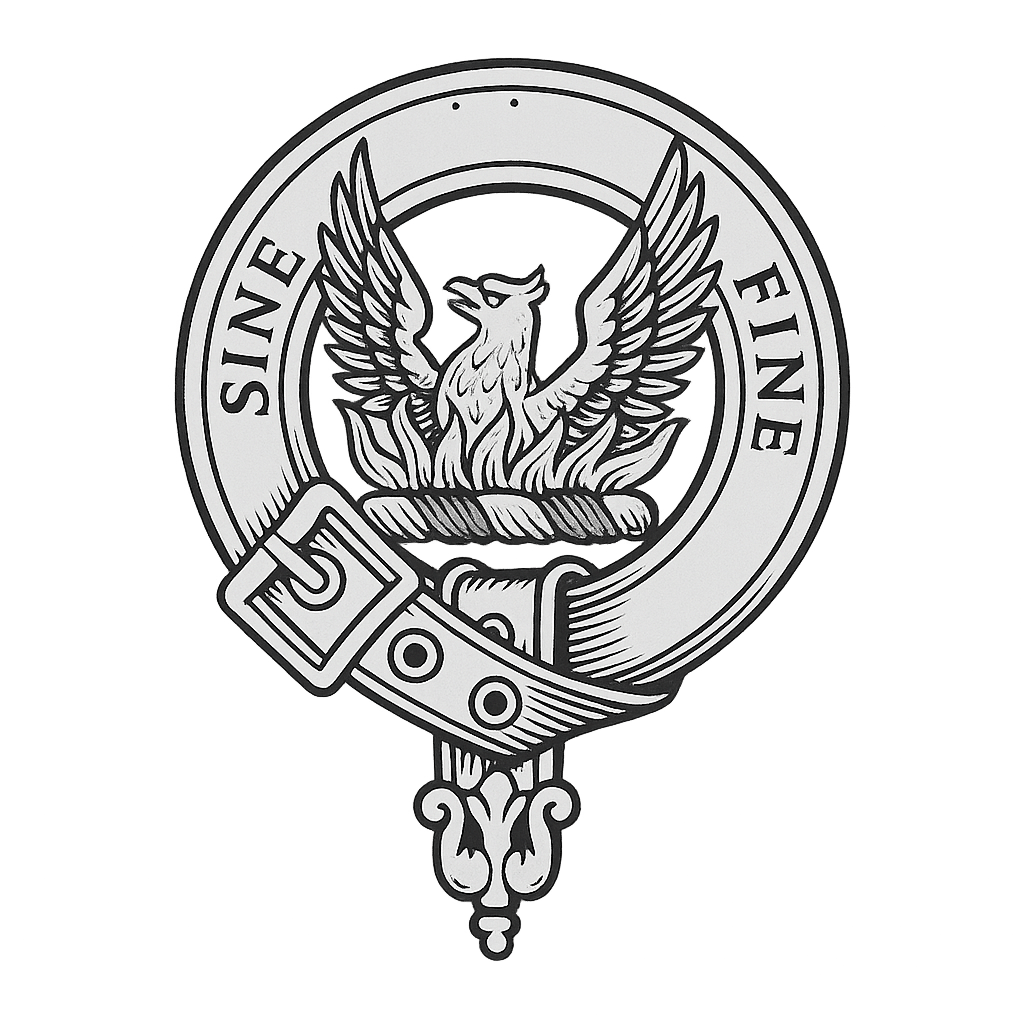
Clan Badge
The wearing of a clan crest badge is a traditional symbol of kinship and allegiance. Historically, a clan chief would grant his crest to kinsmen and followers as a mark of loyalty. In modern heraldry, the badge is represented as the Chief’s crest encircled by a strap and buckle bearing the Chief’s motto. This version is the only form in which a clansman or follower is permitted to wear the Chief’s crest. Only the Chief and his direct heir may display the crest alone, without the surrounding strap and buckle.
- The Makgill crest is described as “A pheonix in flames Proper.”
Arms associated with the Clan
Please note that these coats of arms are fictional and not officially registered to any specific individual. They are artistic interpretations based on traditional heraldic descriptions.
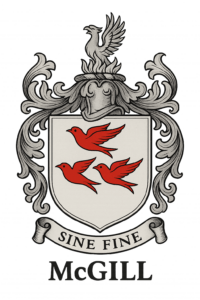
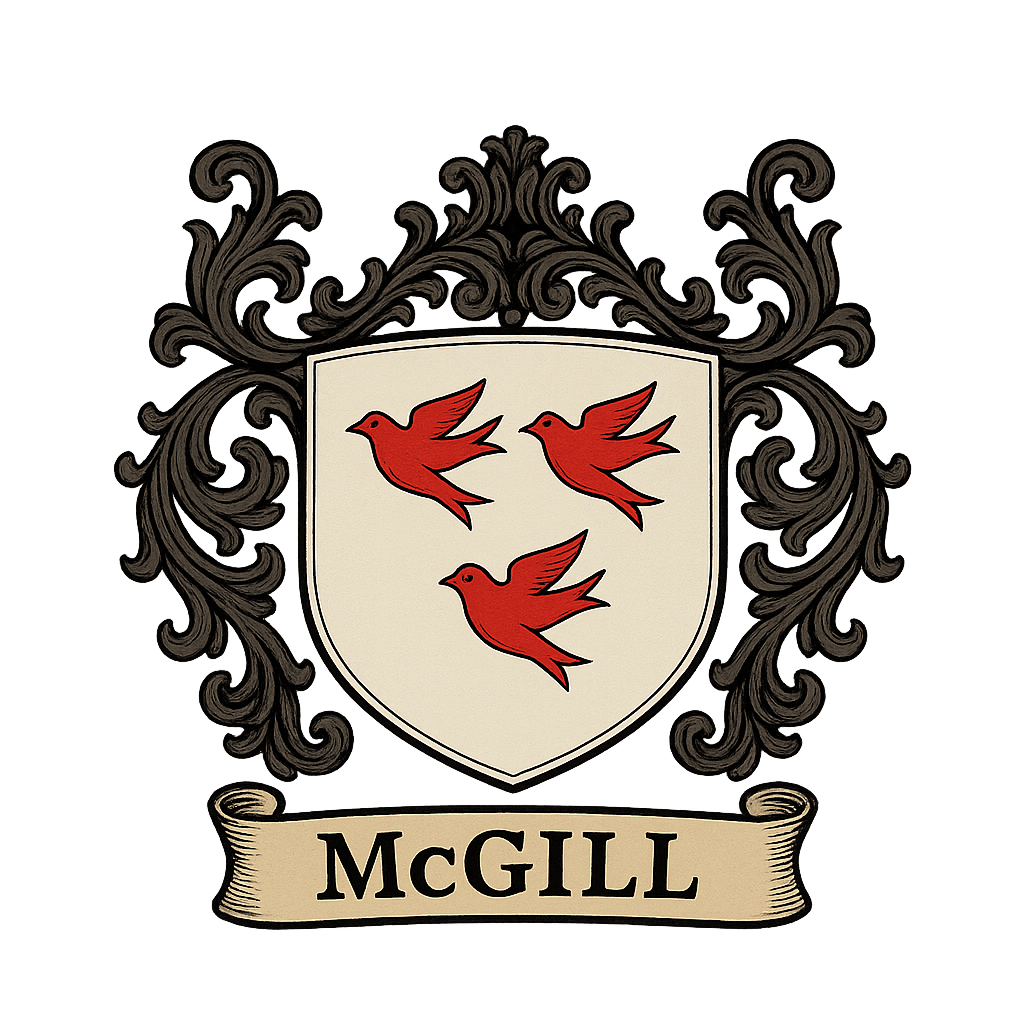
Derivation of the Name
In “Surnames of Scotland,” Black suggests that the name derives from the Gaelic: ‘Mac an ghoill’ – “son of the lowlander” or “son of the stranger”.
Though a Clan in its own right, Makgill is closely associated with Clan Donald.
Of original Clan Donald blood, from Islay or Jura. No more than 1 in 8 Gills originally had a ‘Mac’ prefix.
Chief of the Name
Sir Ian Arthur Alexander Makgill, Bt.
[14 Oct 1969 – ]
The 14th Viscount (of) Oxfuird,
Lord Makgill of Cousland, a Baronet and Chief of Makgill succeeded his Father, Sir George Hubbard Makgill, Bt., 13th Viscount Oxfuird, ho succeeded his uncle, Sir John Donald Alexander Makgill, Bt., the 12th Viscount in 1986. [1899-1986]
The 13th Viscount Oxfuird died on 3 January 2003. [1934-2003]
The Rt Hon The Viscount of Oxfuird,
28B Prince of Wales Mansions,
Prince of Wales Dve,
London SW11 4BQ
Lord Oxfuird has three brothers: a twin, Robert Edward; Hamish Alister; and Edward Anthony. His mother, Venitia (Vee), has an equally interesting Scots history, being able to trace her family decent to Robert the Bruce. Her maiden name was Steward, the former name of Clan Stewart. The family estate in Kemback, near Dundee, sold in the 1920s, they now reside at Hill House, St Mary Bourne.
Viscount of Oxfuird
The title Viscount of Oxfuird was created in 1651 for Sir James Makgill, Baronet, along with the subsidiary title of Lord Makgill of Cousland, with remainder to heirs male whomsoever, a Scottish concept that permitted inheritance by persons not descended from the original grantee, but descended in the male line from male-line ancestors of the grantee.
At the death of the second Viscount, no-one claimed the titles, including the baronetcy, so they all became dormant. The person who should have been fourth Viscount attempted to prove his claim, but was unsuccessful. Thereafter, the matter was generally left alone, until the de jure tenth Viscount actively pressed his claim to the viscountcy and baronetcy. Shortly after his death, litigation was resolved in his favour in regards to the baronetcy, but the viscountcy still remained dormant. John Makgill’s successors also petitioned to revive the viscountcy, but their claims were not admitted until 1977, when Sir John Donald Arthur Alexander Makgill was declared 12th Viscount of Oxfuird.
Lord Oxfuird’s heir, now the 13th viscount, lives in the United Kingdom, as did his lordship in later life. The current viscount, a nephew of Sir Donald, was educated at St Peter’s School, Cambridge, and Wanganui Collegiate School.
The first viscount was a Lord of Session in 1629, one of the judges of the Scottish Court of Session, or High Court. He was a member of the Scottish Parliament from 1630, and of the Committee of the Estates in 1651. He was again a Lord of Sessions from 1661.
The title of Viscount Oxfuird was in abeyance since the death of the second viscount in 1705. Although the family was not extinct, no one individual could claim the exclusive right to it until 1977. Donald Makgill succeeded his father in the right to the title in 1926, though it was not until over fifty years later that he was able to persuade the Committee of Privileges of the House of Lords to admit his claim to the viscountcy. It was thereupon called out of abeyance, and Viscount Oxfuird took his seat in the House of Lords as twelfth Viscount Oxfuird
The armorial bearings of Viscount Oxfuird are Gules three martlets Argent.
The supporters are dexter, a horse at liberty Argent gorged with a viscount’s coronet and thereto affixed a chain, maned and hooved Or. The sinister supporter is a bull Sable, hooved unguled, collared and chained Or. A horse at liberty is rampant, and chained, but the chain is unloosed. A bull with hooves ungules has hooves of a tincture of a different colour than the body, in this case Or on a Sable body.
The crest is a phoenix in flames Proper. In view of the revival of the title in 1977 this is a singularly appropriate crest.
The motto is Sine Fine. Translated as: “Without End” (also translated: “Always and Forever”)
Viscounts of Oxfuird
- James Makgill, 1st Viscount of Oxfuird (d. 1663)
- Robert Makgill, 2nd Viscount of Oxfuird (1651-1706) (dormant 1706)
- David Makgill, 3rd Viscount of Oxfuird (d. 1717)
- James Makgill, 4th Viscount of Oxfuird (d. 1747)
- John Makgill, 5th Viscount of Oxfuird (1676-1762)
- Arthur Makgill, 6th Viscount of Oxfuird (1709-1777)
- George Makgill, 7th Viscount of Oxfuird (1723-1797)
- John Makgill, 8th Viscount of Oxfuird (c. 1790-1817)
- George Makgill, 9th Viscount of Oxfuird (1812-1878)
- John Makgill, 10th Viscount of Oxfuird (1836-1906)
- George Makgill, 11th Viscount of Oxfuird (1868-1926)
- John Donald Arthur Alexander Makgill, 12th Viscount of Oxfuird (1899-1986) (revived 1977)
- George Hubbard Makgill, 13th Viscount of Oxfuird (1934-2003)
- Ian Alexander Arthur Makgill, 14th Viscount of Oxfuird (b. 1969)
Stirnet Genealogy listing of Makgill Cranston Riddel: McGill Listing 1
Stirnet Genealogy listing of Makgill of Kemback: McGill Listing 2
MAKGILL: The Viscount of Oxfuird, Hill House, St. Mary Bourne. Andover, Hants SP11 6BG
The MacGill Tartan
The MacGill Tartan is a beautiful tartan consisting of a sett of six colors: red, green, black, white, yellow, and blue.
The registered MacGill tartan may be worn by several Scotts families: McGill, Gill, Cargill, gillen, Glen and Cairnes.
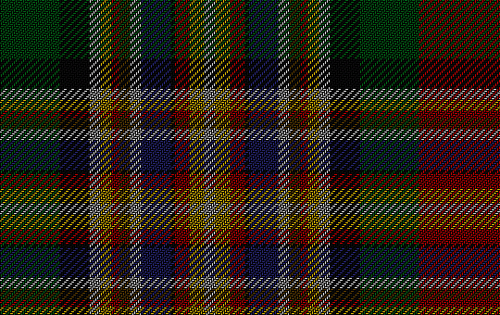
“The family tartan, which originated with the MacGills of Jura, was in use before 1745 but when tartan was proscribed the sett seemed to have been lost until a piece was discovered in Kintyre. It is now in the Museum of Antiquities, Edinburgh. The current version, which first appeared in 1930, is known as the MacGill Society tartan.” (Source: James Pringle Weavers.)
These tartan images below are from The House of Tartan. They have a full line of products in the MacGill Tartan as well as the tartan fabric itself.
It is referred to via the index number 1487 in the MacGregor Hastie Collection.
Color names
There are several tartan variations with differently named color schemes.
- Standard
- Modern
- Ancient
- Muted
- Reproduction
- Antique
“Ancient” colors are distinct from “modern” colors by being less saturated in tone and lighter in shade. The term ‘modern’ refers to the analine dyes introduced c.1860 which produced darker greens and blues and a richer reds and yellows. The term ‘ancient’ should not be confused with the age of the design.
“Muted” colors. A range of tones only slightly different from ‘Modern’. The shades are more subtle, for example, green looks more like olive green.
“Reproduction” colors were created to represent the colors found in a piece of tartan found at Culloden Battlefield. The cloth was around 200 years old and had been preserved by the peat. The colors are therefore made up of brown shades.
“Antique” colors were devised in recent times, (by Johnston’s of Elgin) to represent the warmth and charm of fabrics aged by the sun.
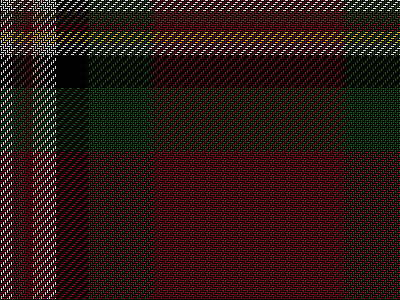
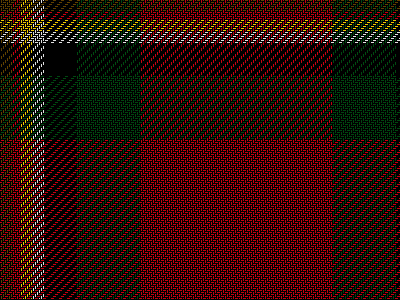
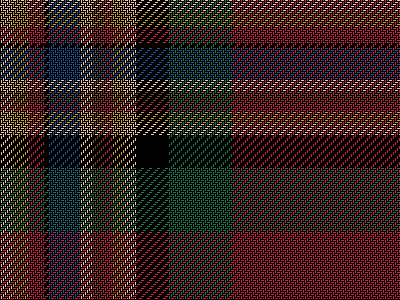
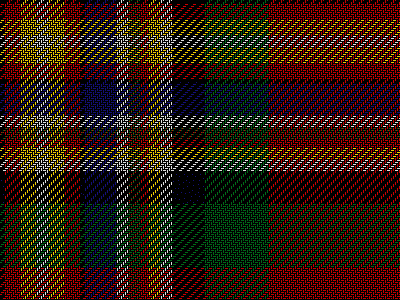
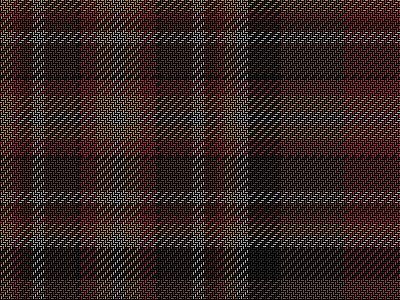
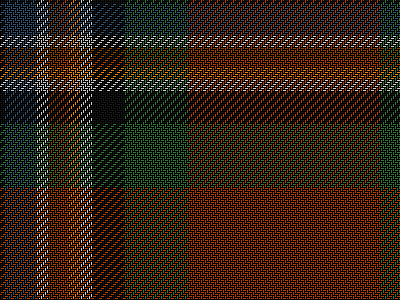
McGill Heraldic Definitions
| gules: | red |
| martlet or merion: | a mythical bird shaped like a martin with feathers in place of its legs, the mark of a fourth son. |
| argent (arg.): | the metal silver, shown as white in heraldic illustration |
| dexter: | the right-hand side of a shield viewed from the position of the person holding it |
| gorged: | encircled round the throat gorges a whirlpool |
| maned: | used of an animal when the mane is of a different colour from the body |
| hooved (hoofed): | used to describe the colour of the hooves of an animal when different from the colour of the animal itself; cloven-footed animals are said to be unguled |
| Or: | Gold |
| sinister: | the left side of the shield |
| sable (sa.): | black |
| unguled: | used of animals’ hooves when they are coloured differently from the body |
| rampant: | used of an animal standing on its hind legs |
Legal Information:
The McGill crest at the top of this page is copyrighted. The information has been gathered from many sites and a good deal from the McGill Society. None of the HTML was copied and only text with open copyrights has been gathered into this composite document. If you have additional information, please send it to me.
